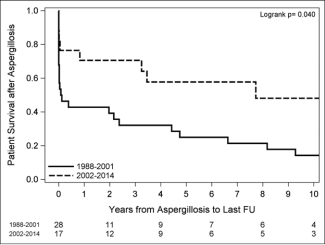Trends in Aspergillus Infection After Liver Transplantation, 1988-2014.
Transplant Hepatology/Transplant Surgery/Infectious Disease, Baylor University Medical Center, Dallas, TX.
Meeting: 2016 American Transplant Congress
Abstract number: D94
Keywords: Fungal infection, Mortality, Survival
Session Information
Session Name: Poster Session D: Fungi, PJP, Mycobacteria, Infection Risk Factors, Vaccination and Donor Derived Infections
Session Type: Poster Session
Date: Tuesday, June 14, 2016
Session Time: 6:00pm-7:00pm
 Presentation Time: 6:00pm-7:00pm
Presentation Time: 6:00pm-7:00pm
Location: Halls C&D
Background: Invasive Aspergillosis is an important cause of morbidity and mortality in liver transplant recipients. Aspergillus may account for up to 25% of all fungal infections in these patients, second only to Candida species. Despite significant improvements in management, there is limited data on the current outcomes of this infection.
Methods: Data was collected by chart review and examination of a prospectively maintained locked-down research database of demographic and clinical variables such as the underlying liver disease, MELD score at the time of transplantation, the site and time of infection after transplant. Kaplan Meier curves were created to estimate survival at 1 year and 5 years after diagnosis.
Results: Between1988-2014, 3,700 liver transplants were performed at our institution; 45 patients developed invasive Aspergillosis: 12 had hepatitis C cirrhosis (26.7 %), 8 had alcoholic cirrhosis (17.8%) and 6 had cryptogenic cirrhosis (13.3 %). The median age was 49, the median MELD score at the time of transplantation was 18. Five patients developed Aspergillosis after retransplantation (11.1%).The lung was the most common organ involved (71%) either alone or with other sites. A majority of cases (67%) were diagnosed within the first year after transplant. In 15.5% of cases, Aspergillus infection was diagnosed at the time of death. The incidence rate of infection decreased from 3/1000 transplants (1988-2001) to 1.1/1000 (2002-2014).We further examined mortality rates pre and post MELD era. From 1988 to 2001, Patient survival was 42.9 % and 25% at one year and five years respectively, but improved significantly to 70.6 % and 57.8% from 2002 to 2014.  .
.
Conclusions: Although invasive Aspergillosis remains a significant cause of mortality in liver transplant recipients, our data shows remarkable improvement in outcome in recent years despite transplanting sicker patients. This trend may be related to advancement of early diagnostics, new antifungal therapies, improved surgical techniques and a better understanding of the delicate balance between immunosuppression and infection.
CITATION INFORMATION: Al Masri R, Jennings L, Asrani S, Klintmalm G, Spak C. Trends in Aspergillus Infection After Liver Transplantation, 1988-2014. Am J Transplant. 2016;16 (suppl 3).
To cite this abstract in AMA style:
Masri RAl, Jennings L, Asrani S, Klintmalm G, Spak C. Trends in Aspergillus Infection After Liver Transplantation, 1988-2014. [abstract]. Am J Transplant. 2016; 16 (suppl 3). https://atcmeetingabstracts.com/abstract/trends-in-aspergillus-infection-after-liver-transplantation-1988-2014/. Accessed December 13, 2025.« Back to 2016 American Transplant Congress
